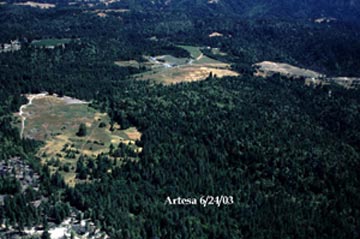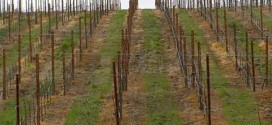Artesa (“Fairfax”)
vineyard conversion
history
| The page contains older information about the proposed conversion. For current information, see: Artesa (“Fairfax”) vineyard conversion. |
Codorníu Napa’s Artesa Vineyards plans to develop a 190-acre vineyard (“Fairfax”) near Annapolis, about five miles east of the Pacific Ocean, between Grasshopper Creek and the Wheatfield Fork of the Gualala River, destroying about 171 acres of forestland in the process.
Update: January 2006
The Environmental Impact Report (EIR) for the Fairfax / Artesa vineyard conversion in Annapolis is still nowhere in sight.
In 2001, Codorníu Napa, a division of a large Spanish corporation, proposed 105 acres of timber removal for a vineyard nearly 200 acres on Annapolis Road, at one of its most scenic vistas.
FoGR and its scientific consultants argued that the conversion would have significant cumulative impacts on streams and forests. The California Department of Forestry (CDF) conceded this, and required the applicant to prepare an EIR. Raney Planning and Management (Sacramento, CA) is the EIR preparer.
Raney and CDF held a public scoping meeting to identify public concerns in September 2004. FoGR members attended and raised many substantial environmental issues for the EIR to address. The public draft EIR was then expected to be released within 6 months.
What happened to the EIR and the project?
FoGR contacted Raney and Allen Robertson of CDF in late fall 2005. They confirmed that there is no scheduled release date for the draft EIR. Robertson reported little activity between CDF’s Sacramento office and Raney. Robertson also said that the application would remain valid indefinitely unless it is withdrawn, no matter how long the inactivity persists. Raney did not explain the cause of the delay, but affirmed that the project is not inactive or withdrawn.
It is highly unusual for over a year to pass between public scoping and draft EIR stages, with no official schedule for draft EIR release. The EIR process is normally complete in one year (draft to final EIR). Is the project’s economic viability being re-evaluated? Is the proposal being reconsidered or revised because of intense public scrutiny and opposition?
FoGR will remain engaged in this precedent-setting vineyard conversion EIR – the first in Annapolis.
Update: September 2004
The Department of Forestry has decided to require an Environmental Impact Report (EIR) for Artesa’s 191 acre project located near Annapolis, CA. Artesa is requesting that 169.5 acres of forestland be exempted from Forest Practice Act tree stocking requirements, so they can be clearcut and converted to vineyard.
At a scoping meeting for the EIR on September 2, 2004, Tim Raney, whose company will prepare the EIR under contract to Artesa, said that he expects a draft to be ready for public review in 3 to 6 months. Written comments on the scope of the EIR are due to the California Department of Forestry by 4:00pm on Monday, September 20th.
Artesa is owned by the multinational corporation Codorníu, based in Spain. They withdrew their previous application for a Negative Declaration in 2003 after substantial public outcry (see below).
About the previous plan
Applicant
Artesa Vineyards & Winery, owned by Codorníu Napa, Inc.
References
Timber Harvest Plan THP 1-01-171 SON;
Timberland Conversion 02-506 (105 acres)

Summary
Artesa applied to the California Department of Forestry (CDF) to clearcut 105 acres of coastal redwood forest in Annapolis, California, and convert the timberland to vineyard. Artesa is owned by Codorníu, a Spanish based corporation, reported to be the world’s third largest winery. This proposed conversion, which would be the largest to date in Sonoma County, threatens the continued survival of coho salmon and steelhead in the affected creeks.
Location
The forestland at risk is located one half mile southeast of Annapolis, in the northwest corner of Sonoma County. The land straddles a ridge; the larger southern portion drains to Patchett Creek, tributary to the Wheatfield Fork of the Gualala River, while the smaller northern portion drains to Grasshopper Creek, then to Buckeye Creek, and finally into the Gualala River. Both Patchett Creek and Grasshopper Creek are “Class 1” (fish bearing) streams.
Environmental impact
The Gualala River was once a famous salmon stream prized by fishing enthusiasts. Today coho salmon are on the verge of extinction, and steelhead survive in large part thanks to the efforts of the Gualala River Steelhead Project’s fish rescue program.
The Gualala River and its tributaries are listed as impaired by the US Environmental Protection Agency for excess sediment and high temperature under the provisions of section 303(d) of the Clean Water Act. Excess sediment and high temperature are harmful to the once abundant but now officially threatened coho salmon and steelhead trout.
In converting forestland to vineyard, clear cutting is followed by complete removal of vegetation and deep ripping of the soil, resulting in total and permanent destruction of a complex forest ecosystem. The stripped land sends large quantities of fine sediment into the river and its tributaries. The vineyard which replaces the forest is a monoculture surrounded by fencing which fragments the former wildlife habitat.
Chemical intensive agricultural methods used by today’s wine industry pose additional risks to the watershed. Herbicides, insecticides and fungicides expose species dependent on the river — including humans — to dangerous toxins. Organic alternatives exist, but are not widely employed. Intensive irrigation of the vineyard and the building of large reservoirs reduce stream flow and could deplete the local aquifer.
According to experts who have reviewed the Artesa plan (see below), the proposed conversion would result in increased sediment, increased water temperature, and decreased stream flows, all of which threaten the continued survival of salmonids in the affected streams.
Analysis
There has never been a completed environmental impact report (EIR) for a conversion of forestland to vineyard in northern California. On the only two occasions in which CDF required an EIR for a conversion, the applicants dropped their plans before completing an EIR (THP 97-412 SON: Gallo, and THP 97-151 SON: Kendall Jackson).
An EIR would document the severe environmental impacts that would result from the proposed conversion, and could lead CDF to deny the plan. Establishing a precedent that EIRs are necessary for conversion permits could slow down the relentless destruction of redwood forest in the Annapolis area, and the degradation of the Gualala River watershed.
Artesa’s is the largest conversion formally proposed to date in the Annapolis area, but numerous other vineyards have been established in the area in the past few years, and the pace of conversions is accelerating. Premier Pacific Vineyards (PPV) floated the idea of a 5,000 to 10,000 acre conversion earlier his year, but backed off temporarily in the face of determined opposition. [In 2009, PPV officially applied to convert ~1,600 acres as part of their “Preservation” Ranch project].
Expert commentary
Local citizens have retained experts to file comments on the Artesa plan (these documents are located on the RRRAUL website):
- Comments by Patrick Higgins, consulting fisheries biologist
- Comments by Peter Baye, PhD, coastal plant ecologist
- Comments by Greg Kamman, geologist and hydrogeologist
- Comments by Dennis Jackson, consulting hydrologist
- Comments by Paul V. Carroll, attorney
Quotes from the experts
“I find the issuance of a Negative Declaration with regard to environmental effects unjustified because of the potential for irreversible and irretrievable loss of cold water habitat in downstream areas…”
“This timber harvest and conversion, in combination with others already permitted, are highly likely to negatively impact steelhead in the basin and will help continue the trend toward increased sediment, increased water temperatures and decreased surface flows. Ultimately the entire aquatic community of the Gualala is at risk from such activities, as more of the river will lose surface flow.”
— Patrick Higgins, consulting fisheries biologist
“The THP contains substantial errors of fact, omission, and self-contradiction regarding potentially significant impacts to jurisdictional wetland, plants, and endangered species.”
— Peter Baye, PhD, coastal plant ecologist
“Many of the data, assumptions, site characteristics, and conclusions regarding potential impacts to local and watershed hydrologic conditions are incorrect and/or misleading in these reports. Because these documents do not accurately evaluate the potential impacts to hydrologic conditions, the project should be reevaluated, requiring the preparation of an Environmental Impact Report (EIR) in order to correct these deficiencies…”
— Greg Kamman, geologist and hydrogeologist
“…a variety of significant hydrologic impacts may arise from the Artesa-Fairfax timberland conversion. These impacts include but are not limited to:
- Insufficient irrigation water for dry years may lead to development of additional water sources with unknown environmental impacts or even abandonment of the vineyard.
- Significantly increased peak flows entering the upper reach of Patchett Creek from several vineyard outlets, the increased peak flows would be expected to increase erosion of the bed and banks of Patchett Creek. The resulting additional sediment load may have an adverse impact on steelhead in lower Patchett Creek. The increased peak flows may also have an adverse effect on the aquatic habitat of upper Patchett Creek.
- The potential for significantly increased levels of suspended sediment in Patchett Creek. The resulting additional sediment load may have an adverse impact on steelhead in lower Patchett Creek. The additional sediment load may also have an adverse effect on the aquatic habitat of upper Patchett Creek.”
— Dennis Jackson, consulting hydrologist
“First, the description of the environmental setting fails to satisfy CEQA… Second, the consideration of alternatives in the proposed negative declaration and THP is inadequate under CEQA… Third, the consideration of cumulative impacts violates CEQA….”
— Paul V. Carroll, attorney
 Friends of Gualala River Protecting the Gualala River watershed and the species living within it
Friends of Gualala River Protecting the Gualala River watershed and the species living within it


